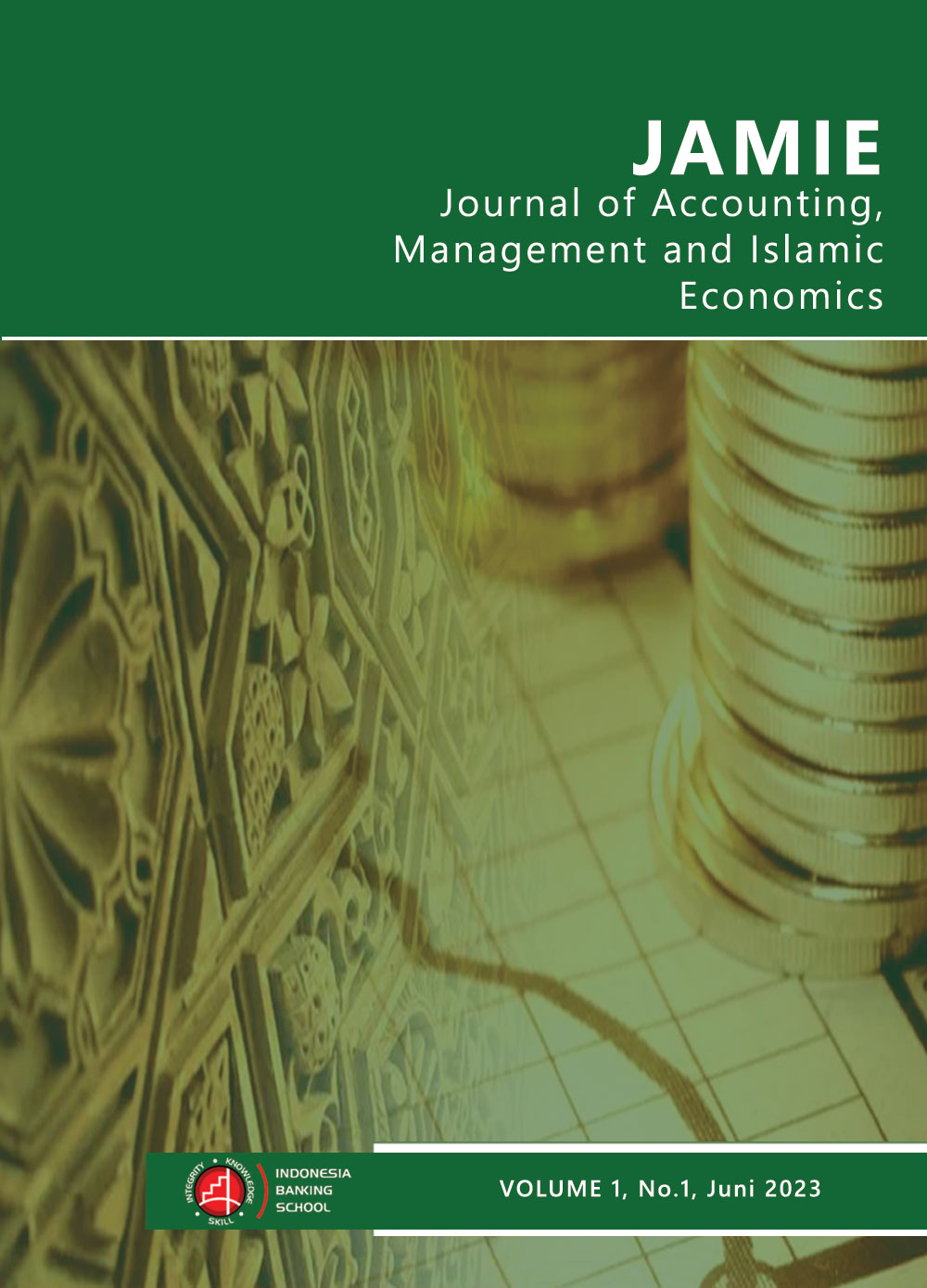PENGARUH GAYA KEPEMIMPINAN, BUDAYA ORGANISASI, DAN WORK-LIFE BALANCE TERHADAP WORD ENGAGEMENT KARYAWAN
DOI:
https://doi.org/10.35384/jamie.v1i1.433Keywords:
Leadership Style, Organization Culture, Work-Life Balance, Work Engangement, PT Bank XAbstract
This study aim to determine the effect of leadership style, Organizational culture, and work-life balance on the work engagement of employees of PT.Bank X Jakarta (Head Office) operational division of kanal elektronik based on the perception of employees of the Bank X. Operational Division Head (Office). 56 respondents data were analyzed descriptively and tested using the structural equation model (SEM). The result showed that the employees of PT Bank had a significant positive effect of a strong leadership style and influenced employee work engagement.Organizational culture at PT Bank X has a positive and significant effect on employee work engagement and word life balance at PT Bank X has a positive and significant effect on employee work engagement.
References
Adriansyah, A., & Afiff, A. Z. (2015). Organizational culture, absorptive capacity, innovation performance and competitive advantage: An integrated assessment in Indonesian banking industry. The South East Asian Journal of Management, 9(1), 70.
Ayu Brahmasari, Ida, & Agus Suprayetno. (2008). Pengaruh Motivasi Kerja, Kepemimpinan dan Budaya Organisasi Terhadap Kepuasan Kerja Karyawan serta Dampaknya pada Kinerja Perusahaan (Studi kasus pada PT. Pei Hai International Wiratama Indonesia).
Azizi, H. (2016). Pengaruh Gaya Kepemimpinan Terhadap Kinerja Pegawai Badan Pusat Statistik di Kalimantan Barat dengan Work Engagement Sebagai Variabel Mediasi. Equator Journal of Management and Entrepreneurship (EJME), 7(1).
Delecta, P. 2011. Work Life Balance. International Journal of Current Research. Vol. 33,4, 186-189.
Denison, D. R. (2009). Getting started with your Denison organizational culture survey results. Erlangga, Jakarta.
Derek R. Avery et al., Engaging the Aging Workforce: The Relationship Between Perceived Age Similarity, Satisfaction With Coworkers, and Employee Engagement, Journal of Applied Psychology : The American Psychology Association, 2007
Djaitun, S., Margono, A., & Irawan, B. (2017). Pengaruh faktor budaya organisasi dan motivasi terhadap prestasi kerja pegawai pada dinas perhubungan provinsi Kalimantan timur. Jurnal Administrative Reform, 1(3), 582-595.
Dewi, W.L., & Ariati, J. (2014). Hubungan antara gaya kepemimpinan transformasional dengan work engagement pada pegawai pelaksana perum perhutani kbm sar wil iicepu. Empati, 3(4).Fisher, G. G., Bulger, C. A., & Smith, C. S. (2009). Beyond work and family: a measureof work/nonwork interference and enhancement. Journal of occupational health psychology, 14(4), 441.
Gambles, Richenda., Lewis, S., dan Rapoport, R. 2006. The Myth of Work–Life Balance: The Challenge of Our Time for Men, Women and Societies. England: John Wiley& Sons Ltd.
Giovanni, J. (2018). Pengaruh Gaya Kepemimpinan Transformasional Terhadap Kinerja Dengan Work Engagement Sebagai Variabel Pemediasi (Studi Eksplorasi Pada Karyawan Usia Muda Di KotaPontianak). Jurnal Ekonomi integra,8(1040.Https://Doi.Org/10.51195/Iga.V8i1.115
Harnoto. 2002. Manajemen Sumber Daya Manusia. Jakarta: Prehallindo.
Hayati, D., Charkhabi, M. & Naami, A. Z. (2014). The relationship between transformational leadership and work engagement in governmental hospitals nurses: a survey study. http://www.springerplus.com/content/3/1/25
Hill, E., Hawkins, A., Ferris, M., & Weitzman, M. (2001). Finding an Extra Day a Week:The Positive Influence of Perceived Job Flexibility on Work and Family Life Balance*. Family Relations, 50(1), 49-58. https://doi.org/10.1111/j.1741- 3729.2001.00049.x
Hudson. 2005. The Case for Work Life Balance: Closing the Gap Between Policy and Practice20:20 Series. Australia: Hudson Highland Group, Inc.
Husen, Umar. 2004. Metode Penelitian Untuk Skripsi dan Tesis Bisnis. Jakarta: Raja Grafindo Persada
Irham Fahmi, S. M. (2016). Perilaku Organisasi (Teori, Aplikasi, dan Kasus). Bandung:Alfabeta.
Kahn, W. (1990). Psychological Conditions of Personal Engagement and Disengagementat Work. Academy Of Management Journal, 33(4), 692-724. https://doi.org/10.5465/256287
Malhotra, Naresh, K. 2005. Riset Pemasaran Pendekatan Terapan. Jakarta: Penerbit PT. Indeks.
Mathis, R. L., Jackson, J. H., & Valentine, S. R. (2015). Human resource management Essential perspectives. Cengage Learning.
Ogbonna, E., & Harris, L. C. (2000). Leadership style, organizational culture and performance: empirical evidence from UK companies. international Journal of human resource management, 11(4),766-788. https://doi.org/10.1080/09585190050075114
Prahara, S. A. (2020). Budaya Organisasi dengan Work Engagement pada Karyawan. Jurnal RAP (Riset Aktual Psikologi Universitas Negeri Padang), 10(2), 232. https://doi.org/10.24036/rapun.v10i2.106977
Robbins, S. P., & Timothy, J. A. (2017). Organizational Behaviour. (S. Wall, Ed.) (Global). Edinburgh Gate: Pearson Education Limited.
Schaufeli, W., & Bakker, A. (2004). Job demands, job resources, and their relationship with burnout and engagement: a multi-sample study. Journal Of Organizational Behavior, 25(3), 293-315. https://doi.org/10.1002/job.248
Schaufeli, W. B., Bakker, A. B., & Salanova, M. 2006. The Measurement of Short Questionnaire: A Cross-National Study. Educational and Psychological Measurement, 66(4), 701–716. http://doi.org/10.1177/0013164405282471
Segers, J., De Prins, P., Brouwers, S. (2010). Leadership and engagement: a brief reviewof the literature, a proposed model, and practical implications. In Albrech, S. A. (Ed.). Handbook of work engagement: perspective, issues, research, and practices.Cheltenham: MPG Books Group.
Sugiyono. 2012. Metode Penelitian Kuantitatif Kualitatif dan R&D. Bandung: Alfabeta
Downloads
Published
Issue
Section
License
Copyright (c) 2023 Journal of Accounting, Management and Islamic Economics

This work is licensed under a Creative Commons Attribution 4.0 International License.

